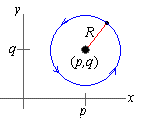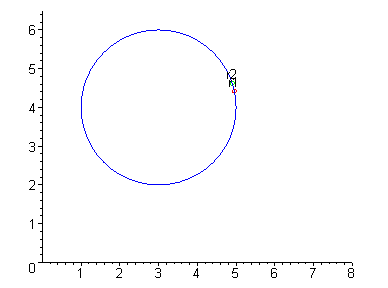Part 3: Parametrizations of Circles
Suppose we are given a circle with radius R centered at a point ( p,q) :

The standard parametrization of such a circle with counterclockwise
orientation is given by
|
r( q) =
á p+Rcos( q),q+Rsin( q)
ñ |
| (2) |
where q is in radians.
EXAMPLE 6 What is the standard parametrization of a circle
with radius 1 centered at ( 0,1) ?
Solution: Substituting p = 0, q = 1, and R = 1 into (2) yields
|
r( q) =
á cos( q),1+sin( q)
ñ |
|
To verify this, notice that x = cos( q) and y = 1+sin( q) implies that
|
x2+( y-1) 2 = cos2( q) +sin2(q) = 1 |
|
Notice that example 5 and example 6 are parametrizations of the same
curve, thus demonstrating that parametrizations are not unique. Indeed, in
applications, the speed at which the circle is being traversed is often
important information.
Specifically, if an object is moving in a circle with a constant angular
speed w in radians per second, then q = wt. Thus, the
path of an object moving in a circle of radius R centered at (p,q) with a constant angular velocity w is parametrized by
|
r( t) =
á p+Rcos( wt),q+Rsin( wt)
ñ |
|
It then follows that the circle centered at ( p,q) with radius
R has a different parametrization for every possible value of w.
EXAMPLE 7 Two objects are moving on a circle with radius 2
centered at ( 3,4) . The first is moving at an angular speed of
w = 2 radians per second while the second is moving at an angular
speed of w = 3 radians per second. Parametrize the motion of each
object and compare the two.
Solution: If we denote the two motions by r1(t) and r2( t) , respectively, then
|
r1( t) = á 3+2cos( 2t),4+2sin( 2t)
ñ |
|
|
r2( t) = á 3+2cos( 3t),4+2sin( 3t)
ñ |
|
|
Moreover the second object will traverse the circle 3 times for every 2
traversals of the circle by the first object. Indeed, r1(t) and r2(t)
are shown below for ever increasing values of t.
 |
|
click to toggle animation |
|
Check your Reading: What is the Cartesian equation of the
circle in example 7?

